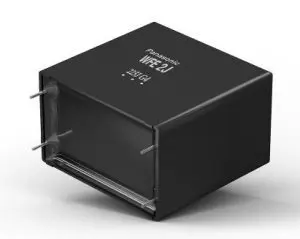source: Electronics Weekly news
Panasonic Automotive & Industrial Systems Europe is introducing a range of small low-loss metallised polypropylene film capacitors for active filters, high frequency circuits and high current circuits.
ECWFE capacitors have been designed with non-inductive, low acoustic emission, construction with a flame retardant plastic case and come with a built-in fuse function.
During manufacture, moulds are incubated to allow the material to cure before vacuum treatment to remove excess air bubbles.
“The durable outer box construction of the ECWFE series capacitors gives the components the capability of withstanding vibrations better than standard dipped type film capacitors,” said product manager Mustafa Khan.
“The built-in fuse functionality allows the ECWFE series to open upon failure rather than short circuit. This makes the parts ideal for power supplies, PFC and other applications where vibrations are a subject of concern.”
Rated for 450Vdc, they range across 0.1µF up to 4.7µF, or 0.1µF up to 2.2µF in the 630Vdc version.
Temperature range is -40°C to +105°C, and they are RoHS compliant.































